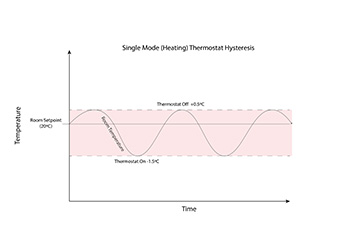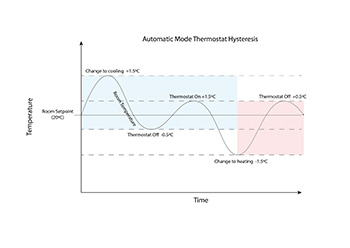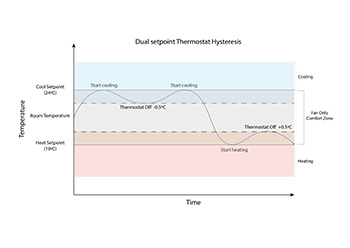Design for wellbeing
Colin Goode asks some searching questions about the design of air conditioning systems in a market that has some pretty tough demands.
How do we design a product that is used in air conditioning? The main aim surely, is for it to do what it says on the tin; provide cooling or heating. But then what? Do we focus on price point or efficiency? Both will sell but meeting one criterion doesn’t necessarily mean achieving the other.
 |
| Fig 1: Single mode Heating Thermostat |
For years we have had to design with all three points in mind, but now there is an additional aspect to consider. Health and wellbeing have become much more of a focus and we need to understand that the relationship we have with our environment will have direct effect on our physical and mental state.
Data collected by the UK Green Building Council has shown that not only will occupational wellbeing have an effect on a personal level, but also on an economic one through productivity. So, as many of us spend a great deal of our time occupying the buildings we work in, designing air conditioning products with wellbeing in mind is vital.
A number of different factors within our environment contribute to thermal comfort, including air temperature, radiant temperature, air velocity and humidity. The clothes that we wear, our sweat rate and mean skin temperature are also contributing factors.
So focused are we on designing environments of specific conditions to ‘prevent’ the issues of thermal comfort, we can forget that this is largely subjective and unique to each individual. The real question is; how do we design an air conditioning product to achieve thermal comfort from, to suit an individual’s needs?
In short, controllability is key. For years we have designed air conditioning systems with set control features, such as thermostat regulation, on and off hysteresis and set fan speed variations. However, we now need to take a different approach, through a combination of methods.
We know heat pump air conditioning generally has three operating modes; cooling, heating and automatic. When in a singular mode, the user would set the desired room temperature. The system would traditionally control at fixed parameters; thermostat on and off, -1.5oc and +0.5oc respectively in heating, and +1.5oc and -0.5oc in cooling of the room setpoint. (See Figure 1: Single mode thermostat)
In automatic mode, the indoor unit would switch modes to maintain the desired room setpoint; working on thermostat on and off ±0.5oc, with mode change over occurring at ± 1.5oc respectively. (See Figure 2: Automatic thermostat)
 |
| Fig 2: Auto Thermostat |
This traditional method sets a standard for operation, but with varying model selections and fan coil positioning within a space, optimal results are not always achievable. Offsetting temperature readings and adjusting the hysteresis for thermostat on and off are ways the installer can set up a system correctly; making sure the systems control strategy suits location and application. However, this doesn’t really provide the user control over their environment.
With the introduction of ‘dual setpoint’ control the user now has the ability to create individual temperature bandings to suit their own preference. Dual setpoint control works by creating a ‘comfort’ zone between the requirement for cooling or heating activation. This comfort zone is fully adjustable and as the system operates in ‘fan only’ mode, it also saves energy. (See Figure 3: Dual setpoint thermostat)
This new method of integrated local control it generally doesn’t matter where the unit is sensing from or how the load has been calculated and could minimise the effects caused by most equipment installation and selection variations, along with those fixed control patterns.
More importantly, studies have shown that even a 4oC control variation can lead to a 3% increase in a person’s logical thinking, 7% increase in typing performance and indications of a 3% increase in productivity. This means that having the right control options within an air conditioning system could actually improve the efficiency and even profitability within the workplace.
As designers, we not only have to consider air temperature, but also any draught effects. A draught is unwanted cooling of the body, caused by air movement. Similarly, to other aspects of thermal comfort, draught is based on individual judgement. The selection and installation of a fan coil plays a crucial role in the comfort of the end user. Installed too high and there is no direct cool or heat effect, installed too low and complaints of too much draught are common.
Fan speed selection generally exist as standard through local control, but where do you go when the pre-set high or low speed isn’t enough? Guidance from EN ISO 7730:2005 Ergonomics of the thermal environment, is given in relation to air velocity for a particular type of occupied space, each relating to the predicted mean vote, or in other words the ‘common feeling’ amongst occupants.
 |
| Fig 3: Dual setpoint thermostat |
Ideally a fan coil is installed at a specific height, 3.5 metres in the case of a cassette, but could be installed much lower. Air velocity experienced by an occupant is designed to be at 0.25 m/s, at a distance between one and two metres; when measured directly in the air stream. If the cassette is installed in a low ceiling then potentially the occupant could be experiencing velocities two to three times greater, emphasising the feeling of a draught.
The fan speed can be decreased, but when low isn’t low enough, what then? Built into the local control is the ability to select a band; a simple band of ceiling heights. The fan coil still maintains a variation of selectable fan speeds, but the airflows related to these fan speeds are changed. This means that in the relative ‘occupied’ space, people will experience air velocities of their choice; thereby having the ability to control to their thermal comfort.
It doesn’t matter which area you are working with or designing towards, it is key to remember that a person’s health and wellbeing is directly linked to the productivity within the workplace. Design for and provide the individual with control of their own environment and you are far more likely to have a satisfied and comfortable customer.
Colin Goode is product manager for Fujitsu General Air Conditioning UK







